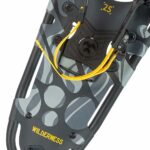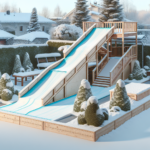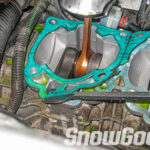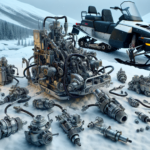Picture yourself in the freezing wilderness, anticipating a day filled with excitement and thrill on your snowmobile. But wait, before anything kicks off, you notice your snowmobile having a mysterious performance drop. You might have a low compression issue, but you may not know what’s causing it. This article takes you into the heart of the matter and discusses various factors causing low compression in a snowmobile. You’ll gain insights on common faults from worn piston rings to leaky valves and much more. Get ready to learn and get the most fun out of your snowmobile rides without any worries.
Understanding Compression in Snowmobile Engines
There’s something freeing about gliding through the snow on a snowmobile, but like all well-oiled machines, they require preventive and corrective maintenance. One of the fundamental components to understand is your snowmobile engine’s compression.
Basics of Engine Compression
Engine compression, or simply ‘compression,’ is the process where the air-fuel mixture in your engine’s cylinders is compressed by the piston before it is ignited by the spark plug. This intense pressure creates a powerful explosion that drives your snowmobile’s engine. The volume of the cylinder when the piston is at the very bottom is referred to as the bore, and when the piston is at the very top, it’s the stroke. The ratio of these two volumes is the engine’s compression ratio and optimally, each should function perfectly to give you a smooth ride.
Importance of Correct Compression
Correct compression is critical to your snowmobile’s engine performance. Proper compression leads to a greater engine efficiency, therefore delivering more power, better fuel economy and a longer engine lifespan. If the compression is too low or too high, the engine will not run optimally and could result in severe damage if not addressed promptly.
Mechanics of Low Compression
Now that you know the basics, understanding the phenomenon of low compression is the next step. Low compression means the air-fuel mixture in the cylinder isn’t getting compressed enough to create a powerful explosion.
Combustion Process in Snowmobile Engines
In a snowmobile engine, the combustion process begins with the intake stroke: the piston moves down the cylinder, sucking in the air-fuel mixture. Next, during the compression stroke, the mixture is compressed then ignited by the spark plug which starts the power stroke – the explosion that pushes the piston back down the cylinder. Lastly, the exhaust stroke, where the piston moves back up the cylinder to expel the exhaust gases.
Symptoms of Low Compression
Low engine compression can lead to several telltale symptoms. Your snowmobile might have a hard time starting or refuse to start altogether. You might also see a significant power loss during your ride or experience backfiring. High fuel consumption and the existence of bluish smoke coming from the exhaust are other common symptoms.
Potential Causes for Low Compression
A variety of factors can cause low compression in a snowmobile. Let’s delve into some common causes: worn-out piston rings, damaged cylinder walls, and faulty gaskets.
Worn out Piston Rings
The piston rings play a crucial role in sealing the combustion chamber and regulating oil consumption. Over time, these can wear out.
Damaged Cylinder Walls
The cylinder walls might get damaged due to wear and tear or because of overheating. This damage could lead to loss of compression.
Faulty Gaskets
The head gasket provides a seal between the cylinder head and the engine block. A blown or faulty gasket can also cause a loss in compression.
Worn out Piston Rings
Identifying and addressing worn-out piston rings is critical to maintaining healthy engine compression.
Signs of Worn Piston Rings
If your engine is consuming excessive oil or there’s bluish smoke coming from the exhaust, these could be signs of worn piston rings. Additionally, a decrease in power and acceleration along with poor fuel economy are other indicative symptoms.
Impact of Worn Piston Rings on Compression
Worn piston rings can let the air-fuel mixture and exhaust gases seep past during compression and combustion. This leakage can cause a reduction in compression and a corresponding loss in power.
Repairing and Replacing Piston Rings
Replacing worn-out piston rings typically involves disassembling the engine. It’s a complex task and requires mechanical skills. However, the first step is to determine the extent of damage through a compression test.
Damaged Cylinder Walls
Let’s explore the effect of damaged cylinder walls on engine compression.
Signs of Damaged Cylinder Walls
If your snowmobile is losing power, emitting excessive smoke, or you notice a significant decrease in fuel efficiency – the cylinder walls might be damaged.
Impact of Damaged Cylinder Walls on Compression
Cylinders should be perfectly shaped and undamaged for ideal compression. If the cylinder walls are damaged, the piston might not be able to compress the air-fuel mixture effectively, which can lead to low compression.
Repairing Damaged Cylinder Walls
If your cylinder walls are damaged, a mechanic might suggest engine honing or re-boring depending on the extent of the damage. In some cases, a cylinder replacement might be necessary.
Faulty Gaskets
The next possible cause of low compression is a faulty gasket.
Signs of Faulty Gaskets
Signs of a faulty gasket include the engine overheating, white smoke from the exhaust, or unusually high oil consumption. Also, watch out for coolant leaks and a poorly running engine.
Impact of Faulty Gaskets on Compression
A blown or leaking gasket can cause a loss of compression as it prevents a proper seal between the cylinder head and the engine block.
Replacing Faulty Gaskets
Replacing a faulty gasket often involves engine disassembly and should ideally be done by a professional. It’s a labor-intensive process but essential to avoid further engine damage.
Testing For Low Compression
If your snowmobile is showing signs of low compression, the first step is to conduct a compression test.
Tools Required for Testing
To test for low compression, you’ll need a compression tester – a gauge that measures the amount of pressure produced when the engine is cranked.
Steps in Compression Testing
Start by removing the spark plug and inserting the compression tester into the spark plug hole. Crank the engine and read the gauge. Repeat the procedure for each cylinder.
Interpreting Compression Test Results
Each snowmobile engine type will have an ideal compression range mentioned in the manual. If the readings are significantly lower than the specified range, your engine has low compression.
Preventing Low Compression
Prevention is always better than cure when it comes to your snowmobile engine.
Regular Engine Maintenance
Regularly checking and maintaining your engine can prevent many issues related to low compression. This includes timely oil changes, air filter cleaning, and spark plug maintenance.
Proper Use of Fuel and Oil
Using the right type and quantity of fuel and oil is crucial. Always follow the manufacturer’s recommended guidelines.
Avoiding Excessive Load on the Engine
Avoiding excessive load on the snowmobile engine can reduce the chances of damage to the engine parts and overheating.
Effects of Low Compression on Snowmobile Performance
Low compression can affect your snowmobile’s performance in several ways.
Impact on Engine Power
Low compression can affect the engine’s power output. Because the combustion process isn’t as effective, the engine won’t produce as much power, detrimentally affecting your snowmobile’s performance.
Effect on Fuel Efficiency
Low compression can cause a decrease in fuel efficiency since the engine isn’t burning the air-fuel mixture at an optimum ratio.
Effect on Snowmobile’s Lifespan and Value
Continuous low compression can cause irreparable damage to your snowmobile engine, reducing its lifespan and value.
Seeking Professional Help
Sometimes, despite your best preventive efforts, your snowmobile might need professional attention.
When to Seek Professional Help
If you’re experiencing consistent symptoms of low compression or if your own efforts to identify the issue aren’t successful, it’s time to seek professional help.
Finding a Reliable Snowmobile Mechanic
Look for mechanics who specialize in snowmobiles. Check their reviews and ask for recommendations. It’s crucial to find someone reliable to handle your snowmobile’s care.
Cost Implications of Professional Repair
Considering the cost of parts such as piston rings, gaskets, and labor charges, professional repair can be pricey. However, it’s an investment in your snowmobile’s longevity and performance.
In conclusion, understanding your snowmobile’s engine compression and the factors that affect it will help you keep your machine running optimally. Regular maintenance, timely repairs, and preventative measures are key to your snowmobile’s long, healthy life. Now, you’re well-equipped to hit the snow- knowing your ride’s engine is in top shape.
- What Snowboard Bindings Should I Get? - January 23, 2024
- What Size Screws For Snowboard Bindings? - January 23, 2024
- How To Snowmobile On Water? - January 23, 2024










